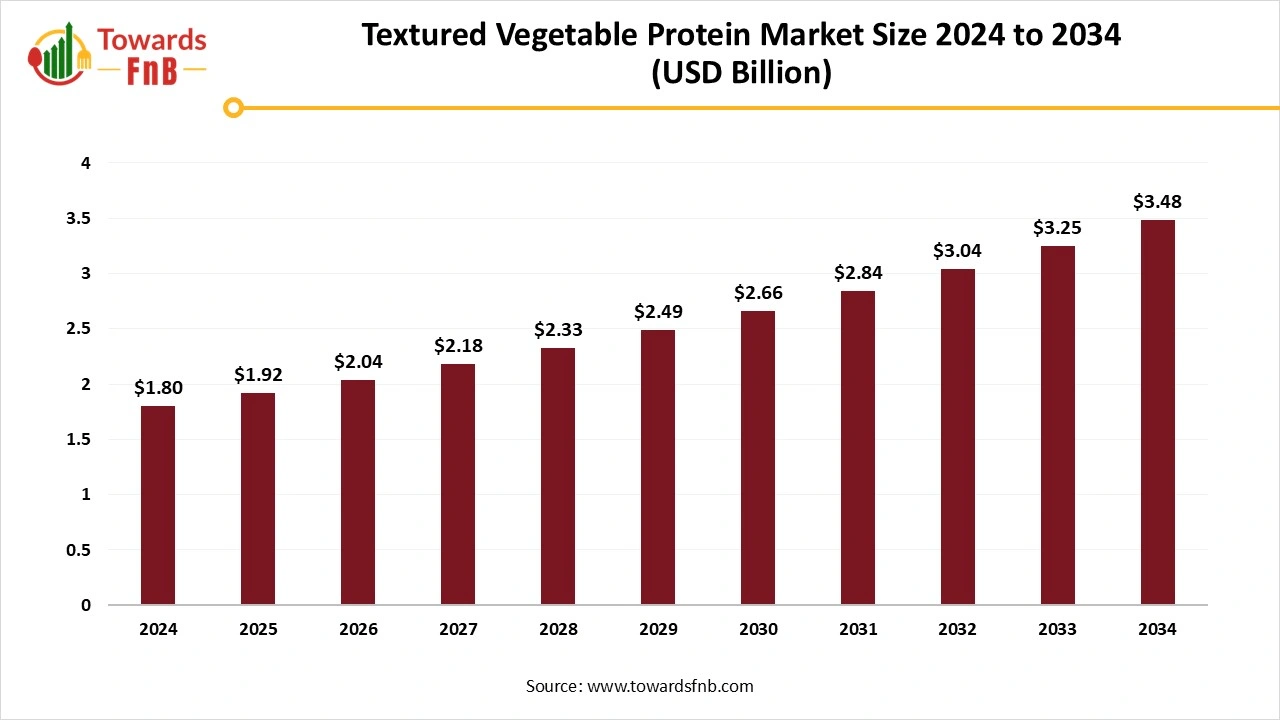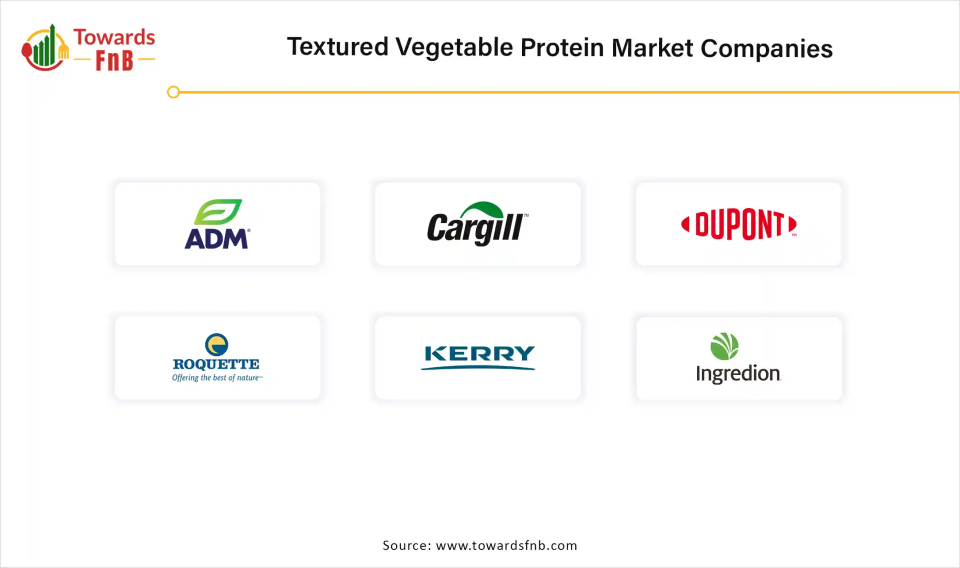December 2025
The global textured vegetable protein market size was reached at USD 1.80 billion in 2024 and is expected to grow steadily from USD 1.92 billion in 2025 to reach nearly USD 3.48 billion by 2034, with a CAGR of 6.97% during the forecast period from 2025 to 2034. The market growth is driven by increasing consumer preference towards plant-based diets, which may enhance consumer health and wellness.

| Study Coverage | Details |
| Growth Rate from 2025 to 2034 | CAGR of 6.97% |
| Market Size in 2025 | USD 1.92 Billion |
| Market Size in 2026 | USD 2.04 Billion |
| Market Size by 2034 | USD 3.48 Billion |
| Largest Market | North America |
| Base Year | 2024 |
| Forecast Period | 2025 to 2034 |
| Regions Covered | North America, Europe, Asia-Pacific, Latin America, and Middle East & Africa |
The textured vegetable protein market refers to the global industry centered on the production and distribution of plant-based, high-protein meat alternatives derived primarily from soy, wheat, or pea protein. TVP is produced by extrusion processing and is commonly used as a meat substitute in both retail and industrial food applications due to its high protein content, meat-like texture, and versatility in various cuisines.
Some of the major factors driving the growth of the market such as rising veganism, vegetarianism, and flexitarian diets, along with concerns over sustainability, animal welfare, and health, the TVP market is growing rapidly. It plays a significant role in the broader plant-based protein and meat alternatives market, catering to both B2C and B2B segments including ready meals, foodservice, and processed foods. In addition, increasing demand for sustainable food products and expansion in developing markets, which are further expected to enhance the market growth.
One of the major opportunities revolutionizing the market growth is the rising adoption of big data analytics and artificial intelligence. Big data analytics and AI plays an important role in the customization and production processes. These technologies offering deeper insights into ingredient optimization and consumer preferences and allow advanced data analysis and processing. AI-derived textured vegetable protein solutions predicting shifts in plant-based food trends, identifying optimal ingredient ratios for texture and taste and allow for more proactive problem solutions.
In addition, this trend enhancing value of TVP and make it more appealing and adaptable to both food manufacturers and consumers. AI technologies can identify to huge array of factors, such as processing parameters, nutritional content, and flavor profiles, which may create significant opportunities in the TVP and further revolutionize the growth of the textured vegetable protein market in the coming years.
One of the major restraining factors hindering the market growth is the allergies related with textured vegetable proteins. Wheat and soy are the major raw materials for textured vegetable protein. These protein components have common allergy content impact the major population that hinder the market growth. In addition, the cost of raw materials, such as soy and pea protein also higher than animal-based protein sources, which further expected to restrain the growth of the textured vegetable protein market.
How North America Dominates Market Revenue in 2024?
North America dominated the textured vegetable protein market revenue in 2024. The market growth in the region is attributed to the increasing consumer awareness towards plant-based protein, increasing demand for meat alternatives, increasing adoption of vegan diets, rising investment in natural components, increasing disposable incomes and growing urbanization. In addition, there is increasing demand for vegetable meat substitutes in products such as meatless meatballs, sausages and burgers, accelerating the demand for TVP in the region. The U.S. and Canada are dominating countries driving the market growth.
The U.S. dominated the market revenue in 2024, driven by the increasing popularity of plant-based diets, reducing environmental impact and improve health. According to the U.S. Department of Agriculture’s Economic Research Service, red meat availability and consumption have increased in recent years, due to plant-based protein increases rapidly.
Asia Pacific Textured Vegetable Protein Market Trends
Asia Pacific is expected to grow fastest during the forecast period. The market growth in the global market is attributed to the increasing disposable incomes, increasing consumer health awareness, growing huge populations, increasing traditional use of soy products, increasing consumer preference towards plant-based food proteins, increasing demand for vegan and vegetarian diets and increasing demand for meat alternatives. China, India, Japan and South Korea are the fastest growing countries driving the market growth.
India is expected to grow fastest during the forecast period, driven by middle-class population, increasing rapid urbanization, increasing consumer awareness of environmental and health issues and increasing presence of plant-based food companies. For consuming plant-based diets, health benefits are the major reason in India. In addition, there are 377 products, across 73 smart protein brands and 41 formats across dairy, eggs and meat available in e-commerce and retail channels. (Source: GFI-Good Food Institute India)
How Soy Protein Segment Dominates Textured Vegetable Protein Market Revenue in 2024?
The soy protein segment dominated the market revenue in 2024. The soy protein is derived from soybeans and consumer can easily add to their diet. Soy protein is the flexible ingredient that may be used in various dishes such as sausages, burgers and ground beef substitutes. Various health benefits related to soy protein such as reduce the risk of breast cancer, boost health and development, maintain hormone balance, build muscle, boost energy and lose weight are expected to drive the segment growth in the market.
The Pea Protein Segment is Expected to Grow Fastest During the Forecast Period.
The segment growth in the textured vegetable protein market is driven by its sustainability, clean-label appeal and allergen-free qualities, increasing demand for well-maintained nutritional profile. Due to the premium alternative to soy and good amino acid profile, pea protein is gaining popularity, appealing to dietary restrictions and health-conscious consumers, which further expected to drive the segment growth.
Why Flakes Segment Held the Largest Textured Vegetable Protein Market Revenue in 2024?
The flakes segment dominated the textured vegetable protein market revenue in 2024. The segment growth in the global market is driven by its defatting and water retention property, increasing demand for meatless plant-based foods, increasing consumer trend towards vegan and clean label, growing food industry and rising innovation in emerging markets.
The Granules Segment is Expected to Grow Fastest During the Forecast Period.
The segment growth in the global market is attributed to the quick cooking process and rehydration, convenience and versatility. The smaller size of granules can enhance faster flavor absorption and make them ideal for several culinary applications, including high-protein snack food and ground meat alternatives, which further expected to drive the market growth.
What Factors Help Meat Analogues Segment Grow in 2024?
The meat analogues segment dominated the market in 2024, is driven by factors such as the increasing consumer preference towards plant-based diets, increasing demand for meat-free alternatives, increasing consumer awareness towards climate change and animal welfare, increasing consumer trends towards nutrition and health and increasing government initiatives and policies to motivate carbon reduction and sustainable protein sources.
The Nutritional Supplements Segment Expects the Fastest Growth During the Forecast Period.
The segment growth in the textured vegetable protein market is fueled by the increasing focus on healthy lifestyles, increasing bone density and increasing consumer awareness towards health and wellness trends. Nutritional supplements are widely helpful in addressing increased nutrient needs of women during their pregnancy. A multivitamin plays crucial role in protecting against some birth defects to addressing normal nutritional needs during pregnancy. To disease prevention and health promotion, the high use of nutritional supplements, coupled with healthy diet, contributed to sustainability, which further drives the segment growth in the global market.
How Food Manufacturers Segment Dominate Textured Vegetable Protein Market Revenue in 2024?
The food manufacturers segment dominated the textured vegetable protein market in 2024 is driven by the safety and compliance, increasing research and development activities, quality control and increasing production process in the food manufacturing industry. Food manufacturers is an essential and vital part of the food supply chain. Into the ready-to-eat products, they are transforming raw ingredients. In addition, food manufacturers also play an important role in ensuring that food is nutritious and safe from the packaging and distribution, which is further expected to enhance the segment growth in the market.
The HoReCa Segment is Expected to Grow Fastest During the Forecast Period.
The segment growth in the market is attributed to the increasing demand for plant-based, vegan and vegetarian diets, increasing popularity of restaurants and hotels, increasing growth of healthy and vegan food chains and increasing consumer trend towards eco-labelling and green dining.
Why Supermarkets and Hypermarkets Segment Held the Largest Textured Vegetable Protein Market Revenue in 2024?
The supermarkets and hypermarkets segment dominated the market in 2024. The segment growth in the market is driven by the increasing consumer desire to shop offline stores without waiting for online delivery, increasing demand for offline stores, increasing accessibility of consumers and widespread reach and increasing growth of in-store organic or natural sections. Supermarkets and hypermarkets are flexible and convenient for shopping for textured vegetable protein products as these channels are convenient and consumer-friendly options for consumers. It has a convenient and longer shelf life. Consumers can feel more comfortable and flexible while shopping with offline retail channels as they can shop for plant-based products for their choice, which is further expected to increase the demand for supermarkets and hypermarkets.
The Online Retail Segment is Expected to Grow Fastest During the Forecast Period.
The segment growth in the textured vegetable protein market is driven by factors such as increasing high usage of internet penetration, increasing preference towards animal-based products, increasing consumer trend for online shopping due to availability and easy access, increasing consumer expenditure on milk protein products and increasing busy and modern lifestyles.
GoodMills Innovation
Cirkla
Nestle

By Source
By Form
By Application
By End-Use
By Distribution Channel
By Region
December 2025
November 2025
November 2025
November 2025